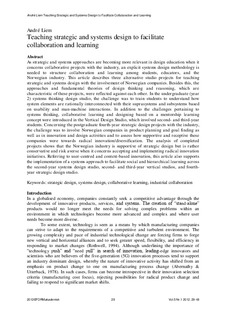| dc.contributor.author | Liem, Andre | |
| dc.date.accessioned | 2019-10-15T08:43:43Z | |
| dc.date.available | 2019-10-15T08:43:43Z | |
| dc.date.created | 2012-08-14T11:20:41Z | |
| dc.date.issued | 2012 | |
| dc.identifier.citation | FormAkademisk - Forskningstidsskriftet for design og designdidaktikk. 2012, 5 (1), 29-48. | nb_NO |
| dc.identifier.issn | 1890-9515 | |
| dc.identifier.uri | http://hdl.handle.net/11250/2622155 | |
| dc.description.abstract | As strategic and systems approaches are becoming more relevant in design education when it concerns collaborative projects with the industry, an explicit systems design methodology is needed to structure collaboration and learning among students, educators, and the Norwegian industry. This article describes three alternative studio projects for teaching strategic and systems design with the involvement of Norwegian companies. Besides this, the approaches and fundamental theories of design thinking and reasoning, which are characteristic of these projects, were reflected against each other. In the undergraduate (year 2) systems thinking design studio, the challenge was to train students to understand how system elements are rationally interconnected with their suprasystems and subsystems based on usability and man-machine interactions. In addition to the challenges pertaining to systems thinking, collaborative learning and designing based on a mentorship learning concept were introduced in the Vertical Design Studio, which involved second- and third-year students. Concerning the postgraduate fourth-year strategic design projects with the industry, the challenge was to involve Norwegian companies in product planning and goal finding as well as in innovation and design activities and to assess how supportive and receptive these companies were towards radical innovation/diversification. The analysis of completed projects shows that the Norwegian industry is supportive of strategic design but is rather conservative and risk averse when it concerns accepting and implementing radical innovation initiatives. Referring to user-centred and context-based innovation, this article also supports the implementation of a systems approach to facilitate social and hierarchical learning across the second-year systems design studio, second- and third-year vertical studios, and fourth-year strategic design studio. | nb_NO |
| dc.language.iso | eng | nb_NO |
| dc.publisher | Høgskolen i Oslo og Akershus | nb_NO |
| dc.rights | Navngivelse 4.0 Internasjonal | * |
| dc.rights.uri | http://creativecommons.org/licenses/by/4.0/deed.no | * |
| dc.title | Teaching strategic and systems design to facilitate collaboration and learning | nb_NO |
| dc.type | Journal article | nb_NO |
| dc.type | Peer reviewed | nb_NO |
| dc.description.version | publishedVersion | nb_NO |
| dc.source.pagenumber | 29-48 | nb_NO |
| dc.source.volume | 5 | nb_NO |
| dc.source.journal | FormAkademisk - Forskningstidsskriftet for design og designdidaktikk | nb_NO |
| dc.source.issue | 1 | nb_NO |
| dc.identifier.doi | 10.7577/formakademisk.374 | |
| dc.identifier.cristin | 938578 | |
| dc.description.localcode | Opphavsrett 2012 Andre Liem. Dette verket er lisensiert under Creative Commons Attribution 4.0 International License. | nb_NO |
| cristin.unitcode | 194,61,45,0 | |
| cristin.unitname | Institutt for design | |
| cristin.ispublished | true | |
| cristin.fulltext | original | |
| cristin.qualitycode | 1 | |

